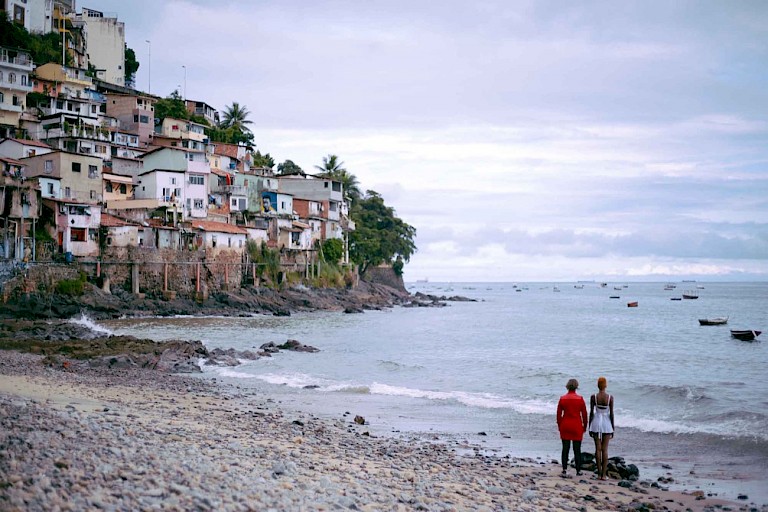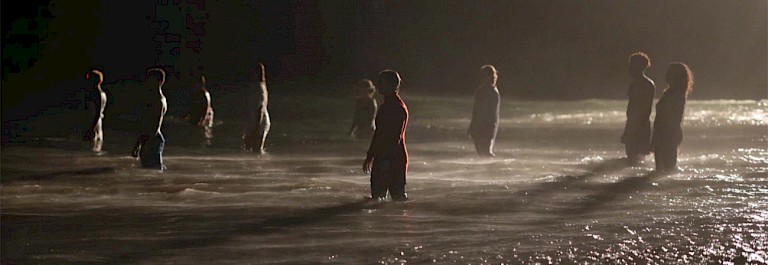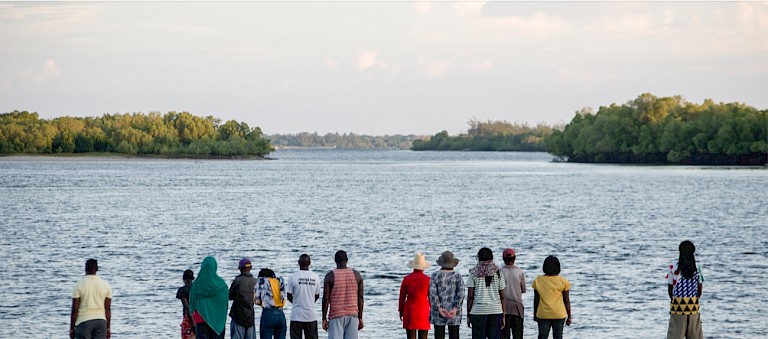



The Artist
Sarah Cameron Sunde is an environmental interdisciplinary artist and director working at the intersection of performance, video and public art. She was recently awarded a Guggenheim Fellowship to complete her ongoing series of works, 36.5 / A Durational Performance with the Sea (2013 – present, nine works on six continents). In 2017, Sunde instigated and co-founded Works on Water (a triennial and artist-driven experimental organisation dedicated to art made on/in/with bodies of water). She served as Deputy Artistic Director of New Georges for 16 years (2001-2017), co-founded the live art collective Lydian Junction (2011-2015) and theatre company Oslo Elsewhere (2004-2012), and is known internationally as Jon Fosse’s American director and translator (five U.S. premieres in New York and Pittsburgh).
As the planet’s most significant carbon sink, our oceans absorb around 90% of the heat generated by greenhouse gas emissions. When the oceans warm, a cascade of effects is unleashed, including rising sea levels, ocean acidification and intensifying extreme weather events such as cyclones and storm surges. These effects have disastrous consequences for marine biodiversity and human settlements, particularly those in low-lying coastal areas.Hurricane Sandy was an example of an extreme weather event that devastated the United States East Coast in 2012, causing over $60 billion in economic damage (Strauss et al., 2021). It also motivated New York-based artist Sarah Cameron Sunde to begin the public art project 36.5 / A Durational Performance with the Sea. She says, “I suddenly realised that we, as New Yorkers, were not paying attention to the water.” The first iteration of 36.5 took place when Sunde found herself standing in the water at Bass Harbour, Maine (2013) for an entire tidal cycle, from low tide to the next, 12 hours, 48 minutes; she describes it as a relatively “spontaneous poetic gesture that came out of months of contemplation about the parallel between an individual struggle to survive on a daily basis and the struggle for humanity to survive in the face of sea-level rise.”“There was something really profound for me that happened when I was out there in the water in Maine, and I really felt the pull of the moon and the pull of the water and understood in my body how connected we all are. And I had to figure out how to make this work in collaboration and with other people around the world who have really different experiences than I do.” (Sunde)Sunde subsequently developed this initial performance into a series with local communities in eight other locations around the world, including Mexico and California (2014), the Netherlands (2015), Bangladesh (2016-17), Brazil and Kenya (2019), Aotearoa New Zealand (2020-22) and finally at home in New York City (2020-22). The poetic gesture of self-immersion in the waters for an entire tidal cycle (12-13 hours) is repeated in each iteration, inviting us to re-experience and reconsider our relationship with the waters surrounding and sustaining us as a species.Sunde was invited by Te Uru Waitākere Contemporary Gallery and the Auckland University of Technology’s School of Art and Design in early 2020 for the Aotearoa New Zealand iteration; the region was significant to the artist due to the severity of the rise in sea levels affecting New Zealand and other Pacific islands as well as the stark differences presented by indigenous Māori perceptions of the natural world. While in Auckland, Sunde worked closely with collaborators including indigenous Māori, Amiria Puia-Taylor (Ngaati Te Ata Waiohua, Ngaati Tiipa, Hamoa, Kuki Airani, Tahiti), Nettie V. Norman (Ngāti Kuri, Ngā Puhi, Ngāti Whakahotu), and Kingi Peterson (Ngāti Kahu ki Whangaroa, Ngāpuhi, Ngati Maniapoto) to learn more about the place and its histories as well as identify an appropriate site.Deciding on Kaitarakihi Bay of Te Manukanukatanga ō Hoturoa (Manukau Harbour) as the location, the artist received permission to carry out the project from Robin Taua-Gordon (Te Kawerau ā Maki Heritage and Environment Officer) and Te Wai-O-Hua kaumatua (elder) Jeff Takua gave the initial blessing for the performance. Scheduled to take place in late March, 2020, the performance was postponed when Aotearoa New Zealand entered a COVID-19 lockdown, and the artist returned to the USA. It was only in May 2022 that Sunde could return to New Zealand, and the performance occurred on the 16th of that month. When she finally stood in the waters of Te Manukanukatanga ō Hoturoa for a tidal cycle, she was accompanied by Amiria Puia-Taylor and Kingi Peterson for the entire time and by others both in the water and onshore for briefer durations.“I travel to a location threatened by sea-level rise to stand in a tidal area for a full tidal cycle, usually 12-13 hours; water engulfs my body and then recedes again. The tide tracks time on my body viscerally, and functions as a metaphor for the changing environment. The water is my collaborator and the risks are real. I stay present in the sensations, attempt to embody the ocean and find a way to endure the struggle. The public is invited to stand in the water with me for however long they like and to participate in performing a series of artistic interventions and gestures from the shore, creating a human clock that communicates to me each hour that passes.” (Sunde)All of the 36.5 performances were filmed in real-time from multiple perspectives and live-streamed from the site, with footage from each performance being edited into a durational video work the same length as the performance. Video is thus an important aspect of the 36.5 project. Two video channels featured in the Aotearoa New Zealand exhibition shown during the first phase of the project in 2020, screening a rotating schedule of the durational video artwork from preceding iterations (The Netherlands, Bangladesh, Brazil and Kenya). The final iteration in New York (also disrupted by COVID-19), perhaps the most ambitious in scale, was accompanied by simultaneous international performances at previous 36.5 sites that were layered into the live stream in outdoor spaces and venues across the five boroughs of New York City as well as around the world. Through the video components, the artist strived to create a slow, immersive experience for exhibition and online audiences and speaks of the totality of 36.5 as a “score,” which she translates for the public moving forward.
Sunde’s skilful combination of the formal aesthetics of land art (the scale and visual language of the oceans as well as the global scope of the project) with the durational and embodied focus of performance art resulted in a complex and multilayered work that involved over 625 participants standing in the waters of the world’s oceans with the artist or taking part in human clock interventions onshore, and approximately 5000 audience members witnessing the nine live performance events. Many thousands more worldwide have tuned into live-streamed or exhibited video works or watched some of the 36.5 works online. Importantly, across all these varied modes of engagement, attention turns to the pressing question of how we function collectively (or not) to contribute to resilience at all levels of scale in the face of the challenges of anthropogenic climate change. This question is especially pertinent from the point of view of Anne Salmond (2017), who writes,“In New Zealand, as elsewhere, shifts towards atomistic ways of being, anthropocentric models and extractionist habits of mind have been associated with fragmentation in social networks, growing inequalities between rich and poor, the incarceration of many young people (especially young Māori men), market failures in housing and finance, and the degradation of fresh water, land and maritime ecosystems – all sites of mate (dysfunction, ill health and disorder). The tears of Rangi themselves – lakes, aquifers and rivers – are becoming toxic, making people and animals sick.” (p. 414)When asked about the lessons learnt from this iteration, Sunde mentions a whakatauki or proverb from the Whanganui iwi (tribe): Ko au te awa, Ko te awa ko au. “I am the river, and the river is me.” This proverb gives expression to a worldview diametrically opposed to the one portrayed by Salmond. Te Ao Māori (the Māori world) is a woven universe wherein “whakapapa is the woven relationship between people and cosmological or divine order, binding whānau and hapu across time and space to Papatūānuku (earth mother), te taiao (the natural environment), tupuna (ancestors) and atua (gods)” (Tan and White, 2023, p. 271). Whakapapa is the sense in which we are one with the rivers and waterways, or tears of Rangi (sky father), without which life would cease to exist.



